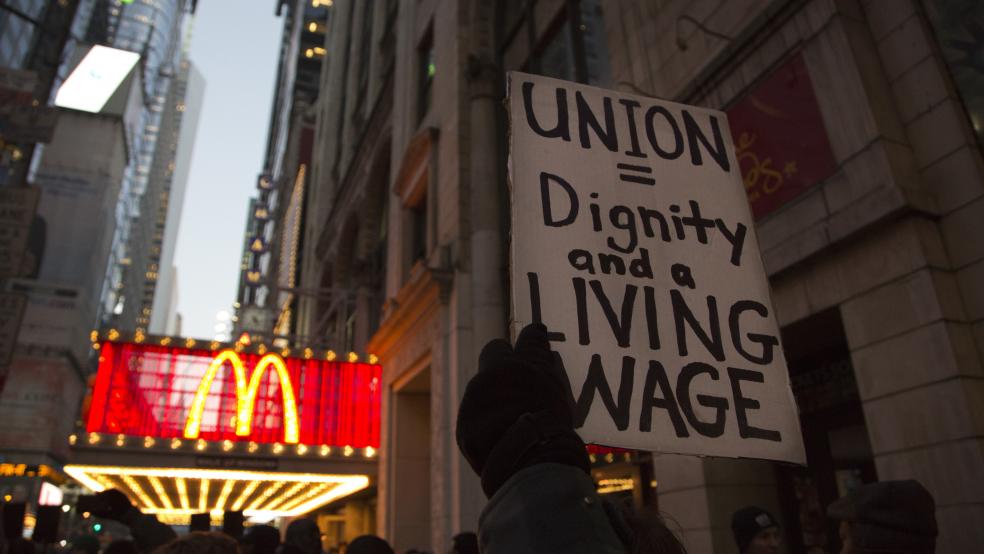For most of us, the prospect of a 40 percent raise in pay would probably be pretty exciting. It would mean a big jump in disposable income, and would probably make it possible to do some things – take that vacation, replace that old car – that weren’t really in the cards before.
The current push to increase the federal minimum wage from $7.25 per hour to $10.10, however, while it would constitute a nearly 40 percent pay raise for minimum wage workers, would almost certainly not translate into a similar increase in their economic wellbeing.
Related: The Truth About Minimum Wage Workers’ Take-Home Pay
For simplicity’s sake, consider a minimum wage worker who regularly works 40 hours per week, 52 weeks per year. This worker would earn $15,080 per year at $7.25 per hour, and $21,008 at $10.10.
That is, unquestionably, a substantial increase. But because of the way programs to aid the poor in the U.S. are structured, that shift would cause federal benefit payments to many minimum wage workers to be significantly reduced. Assistance program for the poor are, by definition, income-based, so as income rises, the payments are either reduced or, in some cases, cut off entirely.
So, while he or she may have more disposable income than before, the post-increase minimum wage earner will be covering a higher percentage of his or her own basic living expenses out of earnings than out of public assistance.
Just how much more? That turns out to be a bafflingly complex question. Public assistance programs are targeted to address many different problems, and typically base their payments on multiple factors, including family size, income level, state of residence, and more. And even within those categories, it’s hard to get a clear read on how changes affect payments. For instance, some income-based programs, like the Earned Income Tax Credit, consider the recipient’s annual income, while others, like the Supplemental Nutrition Assistance Program (SNAP, commonly known as food stamps) are based on monthly income.
Related: Obama’s Overtime “Order” Gets an Overreaction
This graph, from a study by Elaine Maag, C. Eugene Steuerle, Ritadhi Chakravarti, and Caleb Quakenbush, shows not only how many federal assistance programs an individual might qualify for, but also how dramatically some of them cut off at different income levels. (The chart, while somewhat dated, still accurately depicts the complexity of the federal benefits system.)
The changes in federal payments to low-income workers would be dramatically reduced by a minimum wage increase. According to the Center for American Progress, for example, an increase in the federal minimum wage to $10.10 would reduce federal spending on SNAP payments by $4.6 billion per year – money that recipients whose SNAP benefit was reduced would necessarily have to make up out of their increased earnings.
Depending on their income levels, family structure, etc. minimum wage workers could also see a decline in their Earned Income Tax benefit as their take-home pay increases. The EITC, regarded as one of the most successful anti-poverty programs in existence, tapers off as income increases – and again, minimum wage workers would have to make up the difference out of their own earnings.
To be clear, this is not an argument against raising the minimum wage. Advocates of the increase recognize that the change would include tradeoffs, but note that there are a number of social benefits. For instance, the implicit subsidy that allows for-profit companies to employ workers at an artificially low wage would be reduced.
Related: Obama to Campaign for Minimum Wage Hike Despite Opposition
But some feel the more important benefit would accrue to the low-income workers who, while perhaps not benefiting from dramatically higher incomes, would benefit from seeing their work compensated at a level closer to a living wage.
“On the one hand, benefits falling reduces the gains from a minimum wage increase,” said Sharon Parrott, a vice president with the Center on Budget and Policy Priorities in Washington. “But I think people in the real world would rather have higher income and fewer benefits.”
Top Reads from The Fiscal Times






